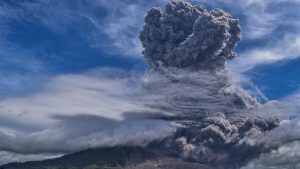Mount Sinabung Erupted: Indonesia:

Indonesia’s Mount Sinabung, located in the North Sumatra province, erupted in May 2021 belching a massive column of volcanic ash and smoke 3,000 meters (3 km) into the sky.
- The volcano has been active since 2010 when it erupted after nearly 400 years of inactivity.
- Indonesia is home to many active volcanoes owing to its location in the “Ring of Fire” or the Circum-Pacific Belt — an area along the Pacific Ocean characterized by active volcanoes and frequent earthquakes.
- The Ring of Fire is home to about 75 percent of the world’s volcanoes and about 90 percent of earthquakes also occur here.
- Basically, there are three types of volcanoes — active, dormant, or extinct.
- An eruption takes place when magma (a thick flowing substance), which is formed when the earth’s mantle melts, rises to the surface.
- As magma is lighter than rock, it is able to rise through vents and fissures on the surface of the earth.
- Following the eruption, the magma is called lava.
- When the magma is runny and thin, gases can easily escape it. In such cases, the magma will flow out towards the surface.
- However, if the magma is thick and dense and gases cannot escape it, it builds up pressure inside resulting in a violent explosion.




